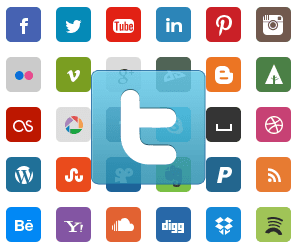
Social media plays an invaluable role in marketing. With so many social media platforms, there’s an outlet to suit any industry, company, product, or service.
Social media offers a multitude of benefits for your business, from building and personifying your brand to targeting new leads and engaging with your following.
However, it’s not as simple as jumping on a platform and sharing a post occasionally. Using social media platforms for marketing requires a systematic approach.
In this article, we discuss the basics of using social media for marketing and provide specific pointers for individual platforms.
How to Use Social Media Platforms For Marketing
Getting started
It’s important to consider what you want to achieve from social media, as this will determine how you use the platforms.
For example, you should create posts directing followers to gated content to capture leads. On the other hand, if inbound marketing is your focus, use educational content, promote your products and share why you do what you do.
Another thing to consider is whether to use the platforms organically or paid. Twitter works well organically, whereas businesses tend to do better on Instagram and Facebook by using paid posts (particularly since the platforms change their algorithms).
This is because paid posts give you more control over who sees your post. You’re more likely to reach leads who have never heard of your brand.
Ensure you advertise your social media accounts on your website, in-store, on banners, or wherever is appropriate for your business. If people like what you do, they will follow you on social media.
There is no one-size-fits-all approach, and it may take some trial and error to determine what is best for your business.
Here are a few ways your business can utilise the top social media platforms.
Let’s start with the basics: the general setup of your Facebook page. Make sure you’ve chosen a CTA (call-to-action) and that your page is up-to-date with all your details. Keep your page clear and organised, and ensure it represents your business well.
When using the platform, many businesses have struggled with their reach since Facebook changed its algorithm and have consequently had to turn to paid ads. Facebook offers several types of paid ads tailored to specific goals, such as lead generation, traffic, engagement and more.
However, many businesses still do well organically. The key to mastering the Facebook algorithm is interactions (likes, comments and shares), so start discussions on your posts.
Another way to foster interactions with your prospects and customers is by creating a Facebook group for your business (in addition to your page). Groups generally show up more often on people’s timelines.
Twitter (X)
Twitter is an excellent option for sharing ideas and starting discussions. Share a mixture of your content and external content relevant to your industry.
One of the most important things to note about Twitter is hashtags. They help users find the content they’re interested in. Use popular hashtags as well as those unique to your business or campaigns.
To spread your word further, you can partner with influencers and other relevant accounts to share your posts.
Twitter tends to take quite an informal tone, and various content mediums, including images and memes, work well. Try out some different mediums and see what gets a good response.
Therefore, Instagram is all about photos and is a great platform for B2C companies. Use high-quality photos that show customers using your products. Play with photo editing and filters to match your brand’s aesthetic and create a striking profile.
When using the platform, highlight the lifestyle that comes with your brand rather than pushing your products. Instagram is a great place to emphasise your brand identity.
Instagram stories are a great way to connect with your audience further and begin a dialogue. They're made up of a series of photos and videos. They’re very interactive and a great opportunity to connect with your audience. Be creative.
Use stories, such as behind-the-scenes videos, demonstrations, or employee takeovers, to give followers insight into your business. Also, use polls, follower shoutouts, and questions.
Instagram doesn’t allow hyperlinks within posts, but verified accounts or accounts with more than 10,000 followers can add links to their stories. You can also add your website and contact buttons on your profile.
Hashtags work well for Instagram, too. Similarly to Twitter, hashtags enable users to find your posts even if they’re not following your account.
LinkedIn is relatively different from other social media platforms because it’s more business-focused. However, it also has many similarities.
Try to spark discussions. Ask questions. Ask for advice, tips and experiences.
Just because it’s more business-focused doesn’t mean you should remove the personal touch. Posts or content with personal anecdotes often work well and help followers feel a connection with your business.
LinkedIn allows targeting, so you can highly personalise your posts to suit a particular location or industry.
Success on social media platforms requires interactions, creativity, and consistency. At Flowbird, we can create automated social campaigns tailored to your goals. You’ll be free to concentrate on running your business while we use our marketing expertise to its fullest extent.